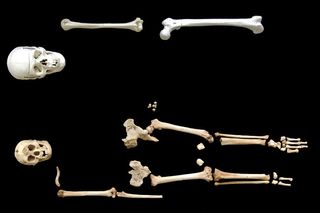Controversial Hobbit Looks Tiny in Person

LONG ISLAND, NEW YORK — The Hobbit looks even smaller in real life.
A skeleton cast of tiny and controversial Homo floresiensis, nicknamed the Hobbit, went on public display for the first time Tuesday at Stony Brook University on Long Island.
The specimen, discovered in 2003 in Indonesia, is hotly debated among scientists. Some claim it represents a new diminutive hominin species, while others argue it is simply a modern human dwarfed by some medical condition.
All agree the original Hobbit was extremely compact compared to us.
"I really had no idea how small it was until now," said Stony Brook undergraduate student Jennifer Kamb, who came to see the skeleton with some other Anthropology majors. "Wow, that skull would fit in my hand."
The cast was unveiled during Stony Brook's 7th annual Human Evolution Symposium, "Hobbits in the Haystack: Homo Floresiensis and Human Evolution."
The tiny skeleton lay down flat next to modern human skull, arm and leg bone casts for comparison, all enclosed in a glass case. The bright display stood on a red cloth-covered table in an atrium in the University's Staller Center for the Arts.
Sign up for the Live Science daily newsletter now
Get the world’s most fascinating discoveries delivered straight to your inbox.
Throughout the day dozens of visitors crowded over the case, almost universally exclaiming on the skeleton's undersized stature next to the human bones. Many people, especially scientists from other institutions, made the trip to see the cast during its one-day showcase. At the end of the symposium the cast was packed up to be shipped back to Indonesia.
"This is the first time the bones have been displayed. It's an honor for Stony Brook," undergraduate student Anna Szczepanek said.
"It's smaller than I imaged it to be," said Stony Brook anthropology graduate student Katie Slivensky. "It's neat to see everything laid out. I remember the extreme shock and surprise when [the discovery] was first announced. It's great to see it come this far."
Homo floresiensis lived on the Indonesian island of Flores until about 17,000 years ago — relatively recently on the timescale of human evolution. It apparently made stone tools, lived in caves, and walked upright. There is some evidence that it may have hunted and used fire.
Yet its anatomy seems to be primitive. Many Homo floresiensis features, such as the shoulder, wrist, jaw and teeth, more closely resemble earlier hominin species such as Australopithecus afarensis ("Lucy") than modern humans.
"It's kind of the single most fascinating fossil species because it's so new and so surprising. It's something that's not quite been figured out," said Nick Blegen, a graduate student studying archaeology at the University of Connecticut who traveled to see the skeleton with his advisor and some other students.
"When you hear something is small, it's hard to picture it, but seeing it you get a sense of what the anatomy was like," he said.
The Hobbit probably stood around 3 feet 5 inches (104 centimeters) tall, and weighed between 66 and 77 pounds.
The new cast was created by making a 3-D CT (computed tomography) scan of the fossilized skeleton. The original fossils are still in Indonesia.
Many experts who spoke at the day-long symposium argued that the evidence points toward Hobbits being a species of their own, rather than sick humans.
Florida State University anthropologist Dean Falk described a study in which she compared the size and shape of the Homo floresiensis brain (based on scans of the skull) to that of modern humans, chimpanzees, the early hominin species Homo erectus, and humans with a disorder called microcephaly, which has been suggested as an explanation for the Hobbit's small stature. She found the Hobbit brain most closely resembles Homo erectus, and is least like the brain with microcephaly.
"In our view we dispensed at that point with the microcelpahy hypothesis," she said. "It's not just that their brains are small; they're differently shaped. It's its own species."
There are no known pathologies that can account for all the anatomy features seen in Homo floresiensis, Washington University anthropologist Charles Hildebolt said.
Famous Stony Brook anthropologist Richard Leakey, who convened the symposium, said he was swayed, though not convinced, by the evidence presented Tuesday.
"I conclude this seminar with a far greater degree of persuasion than I came in with," he said. "I think the possibility of it being a new species has been greatly strengthened."
The perplexing fossils have grabbed the attention of many non-anthropologists who love a good scientific debate.
"I'd been reading about the Hobbits in [the journals] Science and Nature and trying to follow the arguments," said Gail Habicht, a research administrator and former immunologist at Stony Brook who came over to hear the lectures and see the cast. "This was an opportunity to have it explained to me. I certainly have seen pictures but I had no idea how little she is."
Most Popular



